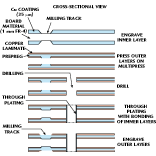Portable Spectrum Analyzers with a Five-minute Warm-up Time
Hewlett-Packard Co.
Santa Rosa, CA
In the demanding world of wireless communications, engineers and technicians are faced with ever-increasing pressure to be efficient with their time. These individuals cannot afford to wait long periods for test equipment to warm up to enable calibrated measurements to be performed, especially if tests are required at more than one location during the day. Some instruments require a half-hour or more of warm-up time before they can provide their specified operating performance. A new portable spectrum analyzer family has been introduced that enhances efficiency by providing a warm-up time of only five minutes utilizing a continuous, automatic alignment function.
Internal Temperature Compensation 
An instrument must be operating in a stable manner before calibrated measurements can be performed. Without automatic alignment, maximum stability cannot be achieved until the instrument's internal temperature is constant. A block diagram of a modern spectrum analyzer is shown in Figure 1 . The analog path comprises a downconverter, IF filter (resolution bandwidth), IF amplifier, detector and video bandwidth filter. When the analyzer is powered on, each analog circuit generates heat. Initially, the internal temperature is not constant, but rises gradually and takes some time before stabilizing throughout the instrument. During the warm-up period, the circuits are affected by these temperature changes, preventing calibrated measurements from being made.
The HP ESA-E series spectrum analyzers achieve specified performance within five minutes by monitoring the temperature in the analyzer and adjusting each analog circuit as necessary to ensure calibrated performance. Because it performs these adjustments only during the time between sweeps, the automatic alignment function never interferes with the spectrum analysis measurements.
Between-sweep Alignment
A spectrum analyzer sweeps across a frequency range and updates the display with the measurement information. Two components make up the measurement update time: the sweep (or measurement) time and the time between sweeps (known as the analyzer's processing overhead). The sweep time depends on the resolution bandwidth and the frequency span of the measurement. The processing overhead is the time required by the analyzer to perform its housekeeping tasks, which include formatting the acquired data for display, setting up for the next sweep and preparing the data for export to an external computer. The analyzer performs the automatic alignment during this time. Processing overhead depends on the number of tasks performed and the number of alignments the analyzer requires to achieve specified performance, as shown in Figure 2 .
setting up for the next sweep and preparing the data for export to an external computer. The analyzer performs the automatic alignment during this time. Processing overhead depends on the number of tasks performed and the number of alignments the analyzer requires to achieve specified performance, as shown in Figure 2 .
The analyzer has several internal alignment sources that may be switched in by relays to perform alignments at the end of every sweep. The HP ESA-E series analyzers offer a full-span RF sweep time as short as 5 ms, thus a large number of relay switching cycles can occur during the instrument's lifetime. Only relays specified with an operating life of more than one billion cycles are used to ensure they will last for the life of the analyzer.
ATTENUATOR Alignment
Since microwave relays can cause performance and repeatability problems if placed in the transmission path ahead of the input attenuator, the automatic alignment function does not align the input attenuator in the microwave (3 to 26.5 GHz) models. However, attenuator insertion loss is relatively insensitive to temperature changes, so the input attenuator can be satisfactorily calibrated during the five-minute warm-up period by a simple manual process. This calibration is accomplished by connecting the analyzer's front-panel amplitude reference signal to the RF input and pressing a softkey to run a seven-second alignment routine. After warm-up, the manual alignment is required again only if the ambient temperature changes by more than 30°C or more than 24 hours have passed. Since an RF relay can be used ahead of the attenuator in the 1.5 GHz model, the manual alignment procedure is not required for this analyzer.
The Automatic Alignment Process
The HP ESA-E series analyzers feature a fast measurement update rate of approximately 20 updates per second with the automatic alignment function on and 28 updates per second with it off. During the processing overhead time, the analyzer must switch in alignment signals, adjust the hardware parameters for alignment and return the analyzer to the state it was in at the end of the previous sweep. Management of the number of alignments performed is critical for keeping processing overhead to a minimum.
The IF alignment is a good example of how the automatic alignment function operates. Within the IF section, the analyzer aligns the center frequency and gain of the analog resolution bandwidth filters, verifies the amplifier's gain and linearity, corrects any frequency drift and gain errors in the circuitry that drives the digital resolution bandwidth filters and ensures that the analog-to-digital (A/D) converter range is optimum and linear.
The analyzer's selection of which alignments to perform depends on the temperature differences and drifts of the analog circuits between each processing overhead period. For example, if the circuit's drift is small, the alignment for that circuit will be bypassed and its need re-assessed in the next overhead period.
Conclusion
The combination of an automatic alignment function and advanced hardware design allows the HP ESA-E series analyzers to provide absolute amplitude accuracy of up to ±1 dB (9 kHz to 3 GHz) or ±2.5 dB (to 26.5 GHz), and frequency accuracy of up to ±121 Hz after five minutes of warm-up. This performance level was previously available only in more expensive analyzers. Five models are available covering the 9 kHz to 26.5 GHz frequency range. The accuracy, fast warm-up, measurement speed, wide dynamic range and resolution ability of these spectrum analyzers help reduce testing time for a variety of field service, manufacturing, and research and development applications.
Hewlett-Packard Co.,
Santa Rosa, CA
(800) 452-4844.
